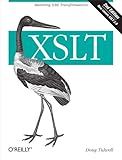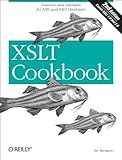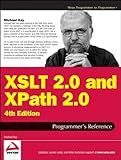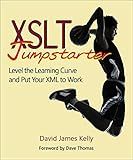Best Tools for XML Transformation to Buy in December 2025

XSLT: Mastering XML Transformations



XSLT Cookbook: Solutions and Examples for XML and XSLT Developers



XSLT 2.0 and XPath 2.0 Programmer's Reference



XSLT Jumpstarter: Level the Learning Curve and Put Your XML to Work


XML (eXtensible Markup Language) and XSLT (eXtensible Stylesheet Language Transformations) are widely used technologies for manipulating and transforming XML data. XSLT is a language that is designed specifically for transforming XML documents into other formats such as HTML, plain text, or different XML structures.
To transform XML using XSLT, you typically follow these steps:
- Create an XSLT stylesheet: Start by creating an XSLT file, which is a separate document that contains the transformation instructions. XSLT files use XML syntax and have the file extension ".xslt" or ".xsl". The stylesheet defines templates and rules that match specific XML elements and define how they should be transformed.
- Define the input XML: You need an input XML file that you want to transform. This XML file contains the data you want to manipulate. It uses tags to define the structure and content of the data. The XML file can be created manually or generated programmatically.
- Link the XSLT stylesheet and XML file: To associate the XSLT stylesheet with the input XML file, you need to specify a reference to the XSLT file in the XML file. This is done using the processing instruction, which indicates which stylesheet to use for the transformation.
- Apply the XSLT transformation: Use an XSLT processor to apply the transformation. XSLT processors are software tools that read the input XML file and the XSLT stylesheet, analyze the transformation rules, and generate the desired output. There are several XSLT processors available, both as standalone tools and integrated into programming languages.
- Obtain the transformed output: Once the XSLT transformation is applied, the processor generates the transformed output based on the rules and instructions defined in the XSLT stylesheet. The output can be in various formats like HTML, plain text, or another XML structure.
Overall, XSLT provides a powerful way to manipulate and transform XML data by separating the structure and content of the data from its presentation and formatting. It allows you to define reusable stylesheets and apply them to different XML documents, making it a versatile tool for XML transformation and data manipulation.
How to install and set up an XSLT processor?
To install and set up an XSLT processor, follow these steps:
- Choose an XSLT processor: There are several popular XSLT processors available, such as Xalan, Saxon, and Libxslt. Choose the one that best fits your needs and operating system.
- Download the XSLT processor: Go to the official website of the chosen XSLT processor and download the appropriate binary package for your operating system.
- Install the XSLT processor: Follow the installation instructions provided with the binary package to install the XSLT processor on your system. This typically involves running an installer and selecting the installation directory.
- Set up the XSLT processor: Once the installation is complete, you need to set up the XSLT processor in your development environment. The steps for this may vary depending on your operating system and development environment. For command-line usage: Add the XSLT processor executable to your system's PATH environment variable so that you can run it from any location in the command prompt or terminal. For programming languages: If you're using a programming language like Java or C#, you need to include the XSLT processor library or module in your project's dependencies. Refer to the documentation of your programming language for specific instructions on how to include external libraries.
- Test the XSLT processor: To ensure that the XSLT processor is correctly installed and set up, write a simple XSLT stylesheet and XML input file. Use the XSLT processor's command-line interface or the programming language's API to apply the stylesheet to the input XML and generate the desired output.
By following these steps, you should be able to successfully install and set up an XSLT processor for your development environment.
What is the purpose of XSLT keys and how to use them?
XSLT keys are used to optimize the retrieval of data in XML documents. They are particularly useful when dealing with large XML documents that require efficient searching and retrieval operations. Keys help to create an index-like structure that improves performance in finding specific nodes or sets of nodes within an XML document.
To use XSLT keys, you need to perform the following steps:
- Define a key: Start by defining a key, specifying the match pattern and the corresponding value. The match pattern determines which nodes should be indexed, and the value defines the value to be indexed against those nodes.
Example:
<xsl:key name="person-key" match="person" use="name" />
- Utilize the key: Once defined, you can use the key to retrieve data efficiently. To retrieve the nodes associated with a specific value, utilize the key() function in your XSLT transformations.
Example:
<xsl:template match="/"> <xsl:variable name="person" select="key('person-key', 'John')" />
</xsl:template>
In the above example, the key() function is used to retrieve all the <person> nodes with a name equal to 'John' based on the defined key 'person-key'.
By utilizing XSLT keys, you can improve the performance of searching and retrieving specific nodes from XML documents, avoiding repetitive and inefficient searches.
How to transform XML to JSON using XSLT?
To transform XML to JSON using XSLT, follow these steps:
- Create an XSLT file: Create an XSLT file that defines the transformation rules from XML to JSON. You can use any text editor to create this file and save it with a .xsl or .xslt extension.
- Define the output format: In the XSLT file, specify the output method as "json" using the element. Here is an example:
<xsl:output method="json" indent="yes"/>
- Define the root template: Create a root template that matches the root element of the XML. Inside the template, use or to loop through the child elements of the root element.
- Construct JSON object or array: Use or to output JSON keys and values. Wrap JSON objects with curly braces and JSON arrays with square brackets. Use concatenation or variable assignment to build nested structures if necessary.
- Recurse through the XML structure: Use to define templates for different types of XML elements. Inside the templates, extract values from XML elements using XPath expressions and output them as JSON keys and values.
- Call the root template: At the end of the XSLT file, use to call the root template. This initiates the transformation process.
- Apply the XSLT transformation: Use an XSLT processor to apply the XSLT transformation to the XML input. Different programming languages provide libraries or functions to perform XSLT transformations. Choose the appropriate method based on your programming language.
- Capture the output: Capture the output from the XSLT transformation and store it in a variable or write it to a file.
By following these steps, you can transform XML to JSON using XSLT. The resulting JSON structure will adhere to the rules defined in your XSLT file.
What is the role of XSLT variables and how to use them?
XSLT variables are used to store and manipulate values within an XSLT stylesheet. They play an important role in increasing the reusability and maintainability of XSLT code. Here is a general understanding of the role of XSLT variables and how to use them:
- Declaration: Variables in XSLT are declared using the element. It has a name attribute to specify the variable name and a select attribute to define the value of the variable. The select attribute can contain XPath expressions to retrieve values from XML input or perform computations.
Example:
<xsl:variable name="varName" select="expression" />
- Reusability: Variables allow you to store intermediate values that can be reused multiple times in the XSLT stylesheet. Instead of re-evaluating the same expression, you can refer to the variable, making the code more efficient and less error-prone.
Example:
<xsl:variable name="taxRate" select="0.25" /> ... <xsl:value-of select="price * $taxRate" />
- Data Transformation: XSLT variables can be used to transform input data into the desired output format. You can assign values to variables and manipulate them using various XSLT functions and operators.
Example:
<xsl:variable name="formattedDate" select="format-dateTime(current-dateTime(), '[M01]/[D01]/[Y0001]')" /> ... <xsl:value-of select="$formattedDate" />
- Conditional Processing: Variables can be used within XSLT conditional constructs like or to control the flow of processing or apply different transformations based on certain conditions.
Example:
<xsl:variable name="isDiscounted" select="price < 100" /> ... <xsl:if test="$isDiscounted"> <xsl:value-of select="price * 0.9" /> </xsl:if>
- Scope: XSLT variables have a lexical scope. Once defined, they are accessible within the block where they are declared and any nested blocks. They cannot be accessed outside their scope.
Example:
<xsl:template match="/"> <xsl:variable name="name" select="'John'" /> ... <xsl:template match="person"> </xsl:template> </xsl:template>
Overall, XSLT variables provide flexibility and control in data transformation by allowing the storage, manipulation, and reuse of values throughout an XSLT stylesheet.
How to create a basic XSLT template?
To create a basic XSLT template, follow these steps:
Step 1: Define the input XML structure First, you need to have an XML file that serves as the input for your XSLT transformation. It should contain the data you want to manipulate or transform.
Step 2: Create an XSLT file Create a new file with a .xsl or .xslt extension to write your XSLT code. You can use any text editor or XML editor to create this file.
Step 3: Define the XSLT namespace and root element In the XSLT file, start by defining the XML namespace for XSLT. This is done using the xsl:stylesheet element as the root element of your XSLT file. You also need to specify the version of XSLT you are using (e.g., version="1.0").
<xsl:stylesheet xmlns:xsl="http://www.w3.org/1999/XSL/Transform" version="1.0">
</xsl:stylesheet>
Step 4: Define the output format Next, specify the desired output format by adding the xsl:output element within the xsl:stylesheet element. You can specify the format as XML, HTML, or text.
<xsl:output method="xml" indent="yes"/>
Step 5: Define the template Inside the xsl:stylesheet element, define the main template using the xsl:template element. Give it a name and specify the match attribute to match the desired XML elements to transform.
<xsl:template match="/">
</xsl:template>
Step 6: Add transformation instructions Within the xsl:template, add XSLT instructions to perform the desired transformation. For example, you can use xsl:for-each to iterate over XML nodes, xsl:value-of to retrieve the values of elements, and xsl:apply-templates to apply other templates.
<xsl:template match="/">
Step 7: Save the XSLT file Save the XSLT file with a meaningful name and the .xsl or .xslt extension.
Step 8: Apply the XSLT transformation To apply the XSLT transformation, you'll need a processor or tool that can process XSLT. You can use libraries like javax.xml.transform in Java, XSLT processors like Xalan or Saxon, or online converters.
That's it! You've created a basic XSLT template to transform your input XML according to your desired output format and instructions.
How to include external files in an XSLT stylesheet?
To include external files in an XSLT stylesheet, you can use the <xsl:include> or <xsl:import> elements. Here's how you can use these elements:
- :include>: Use this element to include another XSLT file with template definitions in your current stylesheet. The included file must have the .xsl extension.
<xsl:stylesheet version="1.0" xmlns:xsl="http://www.w3.org/1999/XSL/Transform"> <xsl:include href="included.xsl" />
</xsl:stylesheet>
- :import>: Use this element to import another XSLT file with its own separate root element. The imported file can be a complete XSLT stylesheet.
<xsl:stylesheet version="1.0" xmlns:xsl="http://www.w3.org/1999/XSL/Transform"> <xsl:import href="imported.xsl" />
</xsl:stylesheet>
Note: The difference between <xsl:include> and <xsl:import> is that <xsl:import> allows you to import entire stylesheets, while <xsl:include> only includes template definitions.
Make sure to specify correct paths (relative or absolute) for the href attribute to locate the external files properly.
By including or importing external files, you can modularize your XSLT stylesheets and reuse common templates or logic across multiple stylesheets.
